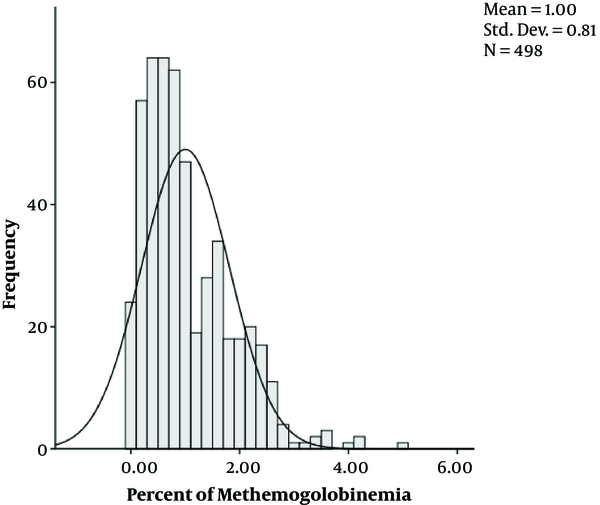1. Background
Methemoglobinemia is a blood disorder caused by iron oxidation of hemoglobin from Fe2+ to Fe3+ state. This condition leads to hemoglobin’s incapability to transport oxygen and causes coma and ultimately death of the patient when methemoglobin level reaches above 60% (1, 2). Methemoglobinemia occurs in hereditary and acquired types (3), with the hereditary type being less prevalent. In this type of methemoglobinemia, patients are usually more tolerant to high levels of methemoglobin compared to those with acquired methemoglobinemia (2). Deficiency of hemoglobin and cytochrome b5 and the presence of hemoglobin M are the most important causes of hereditary methemoglobinemia (3, 4). Acquired methemoglobinemia as the most common type is usually caused by medical and therapeutic interventions such as the use of nitrates, sulfonamides, aniline content materials and local anesthetics such as lidocaine and benzocaine (5-8). The findings of several descriptive studies indicate that in individuals who have used excessive doses of some anti-microbials such as dapsone, methemoglobin level varied from 15% to 47% (9-11).
Nitroglycerin, an important drug for reducing blood pressure, is also known as one of the effective pharmaceutical agents in causing methemoglobinemia (12). Although there are few studies on the effect of nitroglycerin on inducing methemoglobinemia, these studies have shown that high rate of nitroglycerin infusion led to the incidence of methemoglobinemia with symptoms such as cyanosis, lethargy, and hypoxemia (6, 13).
Due to the factors such as variation in the effective factors causing methemoglobinemia and lack of tools for continually measuring methemoglobin level during therapeutic and surgical procedures, there is limited data as to the prevalence and severity of this disorder. Accordingly, many deaths and complications during anesthesia are mistakenly attributed to other factors. In addition to the ambiguities regarding the role of nitroglycerin in methemoglobinemia, there is limited information about the effect of factors such as infusion rate, nitroglycerin cumulative dose and the association of these two factors and factors such as type and duration of surgery with the incidence of methemoglobinemia.
2. Objectives
Therefore, in this study we sought to investigate the prevalence of methemoglobinemia and its association with prescribed nitroglycerin to control blood pressure during anesthesia at Sina Hospital in Tehran, Iran.
3. Methods
The local Human Subject Review Board of Tehran University of Medical Sciences (vice dean for research affairs) approved this study and its ethical issue on 1/10/2014 (code No.: 9311174004). After obtaining informed consent from the participants, this cross-sectional study was performed among patients undergoing surgery at Sina Hospital in Tehran during 2016 - 2017. All the patients received nitroglycerin for the treatment of hypertension during anesthesia. In this study, systolic blood pressure above 160 mmHg or diastolic blood pressure above 100 mmHg was considered as hypertension. After confirming hypertension, nitroglycerin infusion at a dose of 2 mic/kg/min was started and was continued with the goal of reaching blood pressure of 140/90. If necessary, the dose was increased or decreased by 20%. The amount of blood pressure changes was kept below 20% of the baseline, and nitroglycerin infusion was stopped in case of tachycardia above 90 per minute or a drop in blood pressure more than the amount mentioned. The gold standard method of measuring methemoglobin level is the co-oximetry technique. This technique is based on spectrophotometry and employs a maximum absorption of 630 nm as a characteristic of methemoglobinemia.
In this study, SpMet Probe made by Masimo Company was used. This device is used for patients’ pulse oximetry during surgery and shows SpMet% with the precision of 0.1%. To determine methemoglobinemia, at 15-minute intervals during surgery, the percentage of methemoglobin and the variables studied such as blood creatinine level, blood urea nitrogen level, cumulative dose of nitroglycerin, infusion rate of nitroglycerin, saturation percentage of blood oxygen and arterial oxygen pressure were measured and recorded. The frequency of measuring the percentage of methemoglobin is a function of the length of surgery. Other intended information including duration of surgery and patients’ age and weight was extracted using patient records. In terms of the percentage of methemoglobin, the patients were divided into one of the following two groups: a group with methemoglobin percentage of below 2% and a group with a methemoglobin percentage of between 2% and 5%.
3.1. Statistical Analysis
Mean and standard deviation were used to report quantitative variables, and percentage was used for qualitative variables. T-test was used to compare the means of quantitative variables. Backward stepwise logistic regression test was used to determine the factors affecting methemoglobinemia. All the analyses were performed in SPSS version 22 and at the significance level of 5%.
4. Results
The mean age of the patients was 63.8 ± 6.15 years (age range: 30 - 91 years) and 21 (40%) of them were female. The patients’ mean weight was 69.4 ± 2.18 kg (weight range: 50 to 147 kg), and the minimum and maximum durations of surgery were 60 and 360 minutes, respectively (mean: 183.33 ± 56.93 minutes). Also, the range of oxyhemoglobin variation was 91% to 100% with the mean of 97 ± 7.1%. Based on the criterion of methemoglobin level of above 2%, the prevalence of pathologic methemoglobinemia was 56.6% (30 people). From the 53 patients, 498 blood sample were taken and the percentage of methemoglobin was measured (range of variation: 0% to 4.90%, mean: 1.001 ± 0.81).
Figure 1 shows the histogram of methemoglobin level distribution. The comparison of the means of the studied variables between the two groups of normal and pathologic methemoglobinemia is presented in Table 1. Based on t-test, there was no significant difference in the means of the variables between the two groups. The effect of various potential risk factors on pathologic methemoglobinemia is demonstrated in Table 2 using crude and adjusted odds ratios (ORs). After adjusting for confounding variables in the final model, the total dosage of nitroglycerin was the only factor affecting pathologic methemoglobinemia. Accordingly, the OR index for the total dose of nitroglycerin was 1.01. (95% CI: 1.01 - 1.10) (P value = 0.046).
| Variable | Methemogolobinemia, Mean ± SD | P Value | |
|---|---|---|---|
| Normal | Pathologic | ||
| Age, y | 60.2 ± 16.5 | 66.0 ± 14.1 | 0.187 |
| Weight, kg | 68.2 ± 18.0 | 70.9 ± 18.8 | 0.590 |
| Duration of surgery, min | 174.4 ± 51.6 | 190.0 ± 60.6 | 0.340 |
| Cr | 1.3 ± 0.2 | 1.5 ± 0.8 | 0.186 |
| Nitrogen urea, mg/dL | 36.0 ± 17.4 | 29.1 ± 13.3 | 0.108 |
| Mean speed infusion, mic/kg/min | 2.8 ± 1.2 | 3.3 ± 1.7 | 0.196 |
| Total dosage, mic | 21.9 ± 14.4 | 29.1 ± 15.7 | 0.091 |
Comparison of the Mean of Demographic and Clinical Variables of the Patients in Patients with Normal and Pathologic Methemoglobinemia
| Variable | OR Unadjusted | 95% CI | P | OR Adjusted | 95% CI | P Value | ||
|---|---|---|---|---|---|---|---|---|
| Age, y | 0.97 | 0.94 | 1.01 | 0.187 | 0.95 | 0.91 | 1.00 | 0.051 |
| Weight, kg | 0.99 | 0.96 | 1.02 | 0.585 | 0.96 | 0.92 | 1.00 | 0.06 |
| Duration of surgery, min | 1.009 | 0.99 | 1.02 | 0.336 | ||||
| Cr, mg/dL | 0.92 | 0.42 | 2.05 | 0.851 | ||||
| Nitrogen urea, mg/dl | 0.97 | 0.92 | 1.00 | 0.123 | ||||
| Mean speed infusion, mic/kg/min | 0.87 | 0.61 | 1.24 | 0.442 | ||||
| Total dosage, mic | 1.01 | 0.98 | 1.05 | 0.527 | 1.05 | 1.00 | 1.10 | 0.046 |
Simple and Multivariable Logistic Regression for the Associated Factors of Methemoglobinemia
5. Discussion
This study showed the prevalence of pathologic methemoglobinemia after prescribing nitroglycerin and its determinants. We showed that more than half of the patients undergoing surgery suffered from methemoglobin level above 2% after nitroglycerin infusion for the treatment of hypertension during surgery. Other studies in Iran investigated the effect of exposure to other drugs and toxic substances such as aluminum phosphide, indoxacarb and vitamins. However, as they were case reports, they were of low methodological value (14-17). It is worth mentioning that the limited number of studies in different parts of the world makes it difficult to compare our results with similar studies. In this regard, in a review article by Vallurupalli and Manchanda (18), which dealt with the information available on the factors affecting methemoglobinemia, the lack of descriptive and prospective studies (on the prevalence and severity of methemoglobinemia during anesthesia) was mentioned as one of the most important limitations of their study. The results of our study showed that the overall prevalence of pathologic methemoglobinemia was about 57%, indicating that more than half of patients undergoing surgery suffer from abnormal methemoglobin levels.
Kaplan et al. (19) examined abnormal and normal methemoglobin levels after prescribing nitroglycerin among 50 patients and using 141 blood samples. They found that 45% of the blood samples had abnormal methemoglobin levels (2% to 5%), while in our study, 70 (14%) out of 498 blood samples had methemoglobin levels above 2%. In the study by Kaplan et al., the samples were grouped into two groups of methemoglobin below 1% and methemoglobin between 2% and 5%, but it was not clear the samples with methemoglobin levels between 1% and 2% belong to which group.
In a study conducted by Paris et al. (20), the maximum percentage of methemoglobin was 1.6% and abnormal methemoglobin was not observed in individuals who had consumed sublingual nitroglycerin. Another point to note in the diagnosis of pathologic methemoglobinemia is the number that pulse oximetry shows as the saturation percentage of blood oxygen. This number is the result of light absorption ratio at the two wavelengths of 660 nm and 940 nm, and because methemoglobin like oxyhemoglobin can have light absorbance at these two wavelengths, pulse oximetry cannot precisely differentiate between these two types of hemoglobin and will have a high percentage of error (theoretically, oxyhemoglobin number will be observed about 85% with pulse oximetry even if the hemoglobin level is 100%, which is totally far from reality and is caused by the overlap in their wavelength regions). Even changes in the blood percentage of methemoglobin do not have a direct or inverse ratio with pulse oximetry number and this causes this deadly diagnosis to be considered as the blind spot of patients’ routine monitoring in the operating room, recovery room and intensive care unit. In most cases, severe methemoglobinemia has no signs, except a mild drop in pulse oximetry number, and since the pulse oximetry number shows a relative improvement with an increase in the percentage of demi oxygen at the beginning of the process, this makes it difficult to diagnose methemoglobinemia.
According to the results of logistic regression model, the total prescribed dose of nitroglycerin was the only factor associated with abnormal methemoglobin in the final model, and other covariates such as duration of surgery, age, weight, nitrogen urea and mean infusion rate had no significant association with methemoglobinemia. Accordingly, for each unit increase in the total dose prescribed to a patient, the chance of abnormal methemoglobin increased by 5%. This finding is consistent with the results of Kaplan et al. (19), which showed that elevated blood pressure during surgery led to the need for nitroglycerin infusion to control hypertension in most surgeries. Fatigue, lethargy, anxiety, headache, and tachycardia are the common symptoms of methemoglobinemia at lower concentrations (2), and cyanosis, acidosis, coma and even death are not unexpected by increased percentage of methemoglobin (2).
Considering that our results showed that more than half of the patients undergoing surgery suffered from abnormal methemoglobin levels, anesthesiologists are recommended to be more sensitive to the use of nitroglycerin and signs of methemoglobinemia in order for quick and timely diagnosis of this condition and prevention of its serious and sometimes fatal complications.
5.1. Conclusions
This was the first attempt to study methemoglobinemia among patients undergoing surgery at Sina Hospital as one of the vascular surgery referral centers in Tehran. We found that more than half of the patients undergoing surgery suffered from methemoglobin level above 2% after nitroglycerin infusion, and the only predictor of abnormal methemoglobin was the total dosage of nitroglycerin. Anesthesiologists are suggested to be more careful about the nitroglycerin doses, and if a patient needs higher doses, patient care for the early detection of methemoglobinemia should be a priority.



